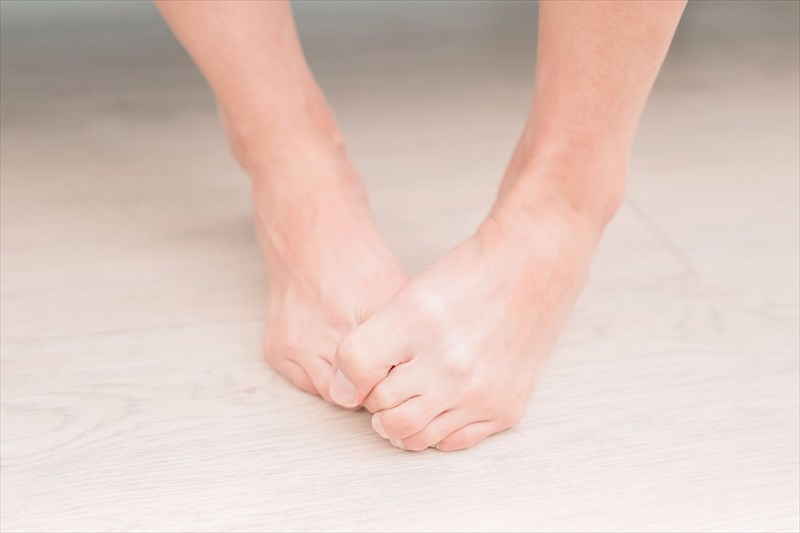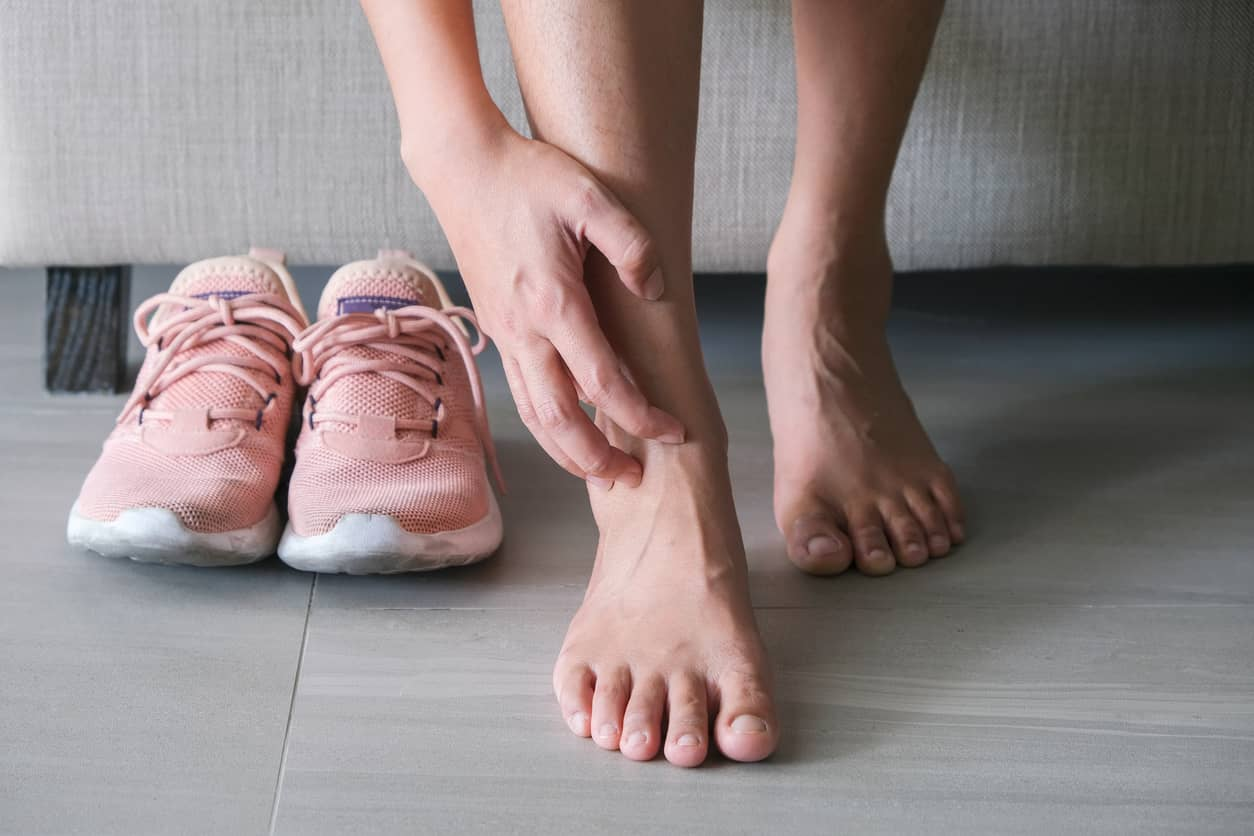Have you ever experienced that irritating itch, stinging, or burning sensation between your toes? You might be dealing with an athlete’s foot, a common fungal infection. A fungus causes this pesky condition and can affect the skin not only between your toes but also on the tops of your feet, soles, and heels. It can make your skin look scaly and cracked or even lead to blistering, along with an unpleasant foot odor. An athlete’s foot is sometimes called ‘tinea pedis,’ where ‘tinea’ means ringworm and ‘pedis’ refers to the foot. Let’s go ahead and dive into what you need to know about this issue.

Photo By: Dapto Foot Clinic.
Contents
Types of Athlete’s Foot
Athlete’s feet can take different forms, and understanding these variations is essential for effective treatment. There are four primary types, each with its symptoms and characteristics.

Photo By: Associates in Medicine & Surgery
An athlete’s foot between toes is a common fungal infection with four types, each having different symptoms and traits.
Moccasin-Type Infection
The moccasin athlete’s foot targets the bottoms of the feet, heels, and foot edges. It causes soreness, and then the skin becomes thick and cracks. In rare cases, toenails may become infected, thick, brittle, and may fall out.
Toe Web Infection
It affects the skin between the fourth (ring toe) and fifth (pinkie toe) toes. Symptoms include skin discoloration, cracking, peeling, and flaking.
Ulcerative Infection
This type is the rarest, marked by open sores (ulcers) between the toes or on the soles of the feet.
Vesicular-Type Infection
It affects the bottoms of the feet, presenting as bumps or fluid-filled blisters (vesicles) that can appear anywhere on the feet.
What Causes Athlete’s Foot?

Photo By: Fitpage
An athlete’s foot is like a sneaky guest at a party, always looking for the perfect opportunity to spread. It’s caused by various fungi that thrive in warm, damp places, such as locker rooms and public showers. What’s even trickier is how it can spread through direct skin contact or by simply contacting infected skin flakes. Surprisingly, it can even hitch on items like towels and socks, turning them into unsuspecting carriers. So, the next time you borrow something from a friend with athlete’s foot, you might be in for an unexpected guest!
Being cautious in shared spaces, especially public showers, is a must, as these fungi tend to linger there. It’s important to note that athlete’s foot doesn’t stop at fungal infections; it can also lead to nasty bacterial infections if your feet get cozy with these fungi.
Athlete’s Foot Symptoms

Photo By: MyMed.com
Suppose you’re a senior experiencing persistent itch or discomfort on your feet. In that case, you might be grappling with an athlete’s foot between your toes—a contagious fungal infection that’s all too common. A few telltale signs characterize this condition:
Itch
One classic symptom of an athlete’s foot, prevalent among seniors, is an unusual and often intense itch beyond the usual discomfort. This itch can manifest between the toes or on the soles of the feet, sometimes accompanied by a burning or stinging sensation.
Skin Issues
Seniors may also notice skin issues that come along with athlete’s foot, like redness, cracking, and the development of scaly, peeling skin.
Blisters
Blisters can be another bothersome symptom seniors may experience with an athlete’s foot. These skin bubbles tend to surface, adding to the discomfort in the feet.
Smell
People might notice an unpleasant smell coming from their feet.
The severity of these symptoms differs from one individual to another. Some people might feel a slight itchiness, while others might find it so bad that walking or wearing shoes becomes hard.
I’d like to point out that seeking the expertise of a healthcare professional, such as a doctor or podiatrist, is essential. They know how to identify and treat athlete’s foot, making sure it gets better.
Who’s Prone to Athlete’s Foot?

Photo By: Superior Foot and Ankle Care Center
Athlete’s foot doesn’t discriminate, but some folks are more likely to deal with it. Those who tend to be at higher risk for athlete’s foot between their toes include:
Athletes and Sweaty Individuals
Sweat creates a perfect breeding ground for the fungus. Athletes and those who sweat a lot are at risk.
Closed Shoes and Socks Users
Wearing closed shoes and socks for extended periods can be especially troublesome for seniors, as it may lead to moisture buildup and increase the risk of athlete’s foot.
Barefoot Walkers in Public Places
Seniors who go barefoot in public areas should be aware that they may expose their feet to the fungus, thus increasing their risk of infection.
People with Weakened Immune Systems
Older individuals, especially those with conditions like diabetes or those taking immune-weakening medications, should be extra cautious, as they are at a higher risk of developing this infection.
Elderly Individuals
As we age, our immune system tends to weaken, making seniors more vulnerable to athlete’s foot.
How Athlete’s Foot Diagnosed?

Photo By: Sutherland Podiatry Centre
Doctors start diagnosing athlete’s foot with a check-up. They ask about the patient’s medical history and examine the affected feet. Sometimes, they may need a more detailed examination, like scraping the skin, to inspect the area.
How is an Athlete’s Foot Treated?

Photo By: Dr. Foot Podiatry
When diagnosing an athlete’s foot, the treatment depends on how bad it is and the person’s health. For mild cases, over-the-counter powders or creams usually work well. But if the athlete’s foot is severe, doctors might prescribe more potent medicines. These treatments are for cases that don’t get better with regular creams.
Is It Possible to Treat Athlete’s Foot With Home Remedies?

Photo By: Parkview Health
Sure, there are some home remedies that you can try, like soaking your feet in water with natural oils such as tea tree oil. These can relieve athlete’s foot symptoms, but it’s worth noting that these remedies may not work for everyone. If you find that your athlete’s foot doesn’t improve with these treatments, it’s time to reach out to a doctor, a foot specialist, or a podiatrist. They have the expertise to create a personalized treatment plan to help your feet get back on the path to health and comfort.
The Risks of Ignoring Athlete’s Foot: What Happens if Left Untreated?

Photo By: Quantum Health
Seniors, being more susceptible to athlete’s foot, should be particularly cautious, as leaving this condition untreated can lead to various complications.
It Spreads
Without treatment, an athlete’s foot can spread from the feet to other parts of the body, including the hands and groin, which is especially concerning for seniors with weakened immune systems.
Gets Worse
Ignoring an athlete’s foot is not advisable, especially for seniors. It can worsen, becoming more painful and potentially leading to swelling. In severe cases, it may even result in painful sores on the feet.
Can Cause Other Problems
At times, an athlete’s foot can trigger unexpected health complications, especially among seniors. These may include conditions such as cellulitis, a skin infection, or lymphangitis, an infection in the lymphatic system.
How to Prevent Athlete’s Foot?

Photo By: Prevention
Let’s talk about how to keep your feet in great shape and prevent athlete’s foot:
Keep Them Clean and Dry
Make sure to clean your feet twice daily using soap and water, paying particular attention to the areas between your toes. Dry them, too; fungus loves moisture.
Shoes and Socks Matter
Wearing breathable shoes and socks is essential for foot health. Avoid tight-fitting footwear, including wool socks, as they can restrict airflow. Wearing sandals is a good choice, especially when running errands for a long time. They ensure your feet stay comfortable and well-aired.
Say No to Bare Feet in Public
Wear flip-flops or sandals in public places like pools and locker rooms.
Switch it Up
Change your socks and shoes. Sweaty gear can attract the fungus.
Post-Pool/Shower Cleanup
After a public swim or shower, wash your feet with soap and water. It helps wash away any hitchhiking fungus.
Foot Powder
Keep your feet dry with antifungal powder or spray.
No Sharing Zone
Avoid swapping towels or shoes with someone who has an athlete’s foot. Direct contact spreads the fungus. Remember, don’t hesitate to chat with a doctor or podiatrist if you’re ever worried about your feet or suspect athlete’s foot. They’ll diagnose the situation and guide you toward the best action plan!
Here’s an additional video on how to get rid of athlete foot Get 5 Ways to Get Rid of Athletes’ Foot | Treatment By: Nurse Sarah Jeffries
Putting Your Best Foot Forward: Conquering Athlete’s Foot with Knowledge and Care!
Understanding the signs, causes, and types of this common fungal infection is essential for seniors. Maintaining healthy feet through prevention is paramount. Simple steps such as keeping feet clean and dry, choosing appropriate footwear, and avoiding public barefoot walking can significantly reduce the risk.
If you think you have an athlete’s foot, I would like you to please seek immediate medical attention. A doctor can provide the proper treatment, which may involve antifungal medication, ensuring seniors enjoy comfortable, healthy, and itch-free feet.
Remember, your feet are your foundation for mobility and independence. Take the first step in caring for them today by staying informed and seeking help if needed. Your well-being starts from the ground up.
FAQs
Can Athlete's Foot Go Away on Its Own?
An athlete’s foot usually doesn’t clear up by itself. Ignoring it can make it worse and lead to spreading to other parts of your body.
How Quickly Will I Start Feeling Better After the Treatment?
After you’re diagnosed and begin treatment, your athlete’s foot should improve in one to eight weeks if you follow your doctor’s advice. Complete the entire medicine course, even if you begin to feel better. Even if the itchiness goes away, the infection might still be there. If you stop the treatment too early, the athlete’s foot could return and be more challenging. So, make sure to complete the entire treatment to get rid of it completely!
Stay Connected with Senior Parents!
Ready to embark on a journey of wisdom and care? Follow us on our social media channels and stay updated with heartwarming stories, expert advice, and valuable insights for senior caregiving!
? Website: Explore sr-parents.com for in-depth articles and resources about senior care, health, and well-being. ? Pinterest: Discover a wealth of caregiving ideas, home hacks, and senior-friendly activities at pinterest.com/seniorparents.
? Facebook: Join our supportive community at facebook.com/sr.parents. Engage with fellow caregivers, share experiences, and find inspiration.
? Twitter: Connect with us at twitter.com/senior_parents for real-time updates, news, and trending topics related to senior care.
? Instagram: Follow us on instagram.com/seniorparents for uplifting moments, caregiving tips, and a glimpse into the lives of seniors and their families.
Stay informed, inspired, and supported with our latest articles and heartwarming stories about senior care. Join our caregiving community and be part of a network dedicated to providing the best for our beloved seniors. Follow us now, and let’s start this rewarding journey together!




